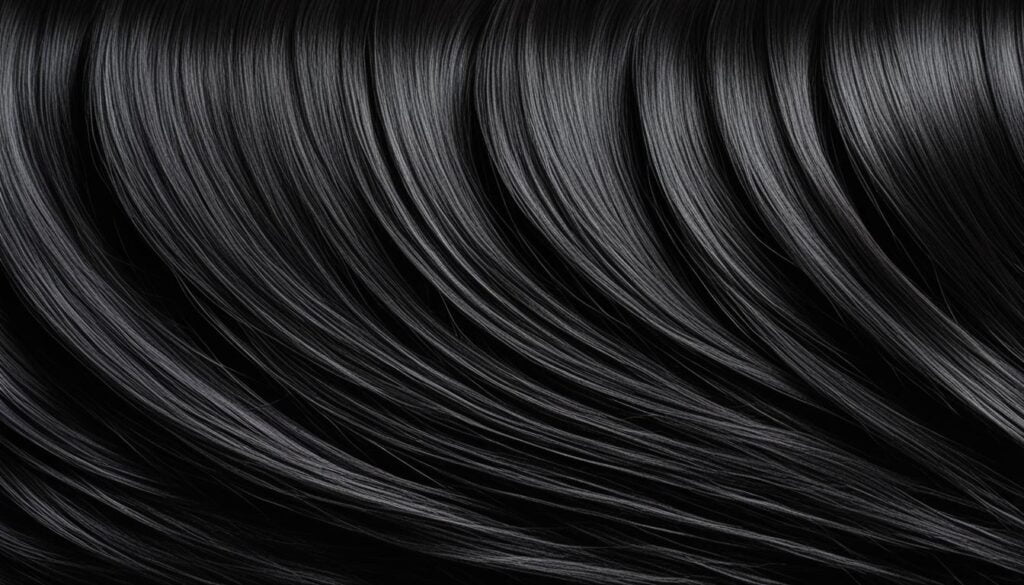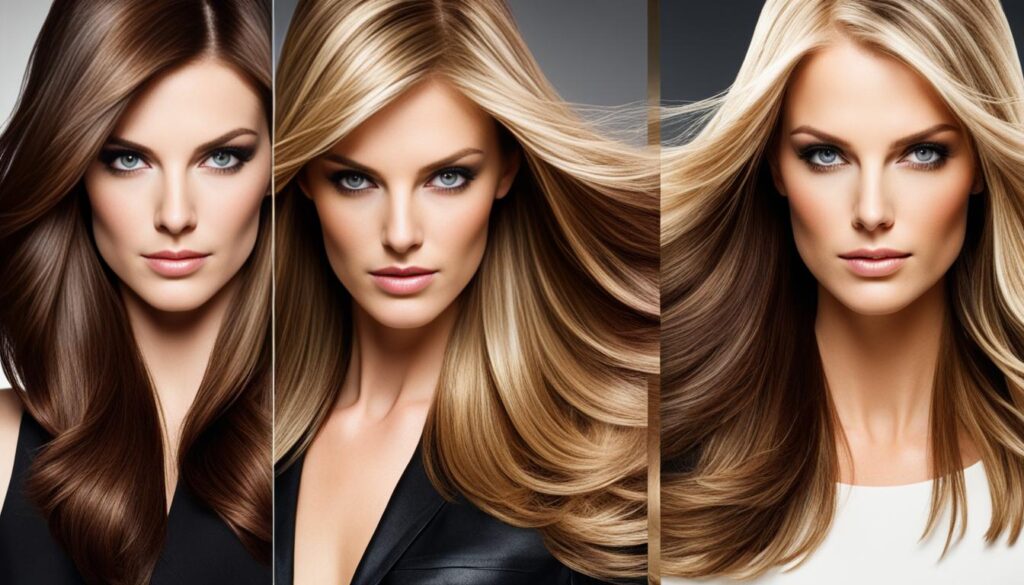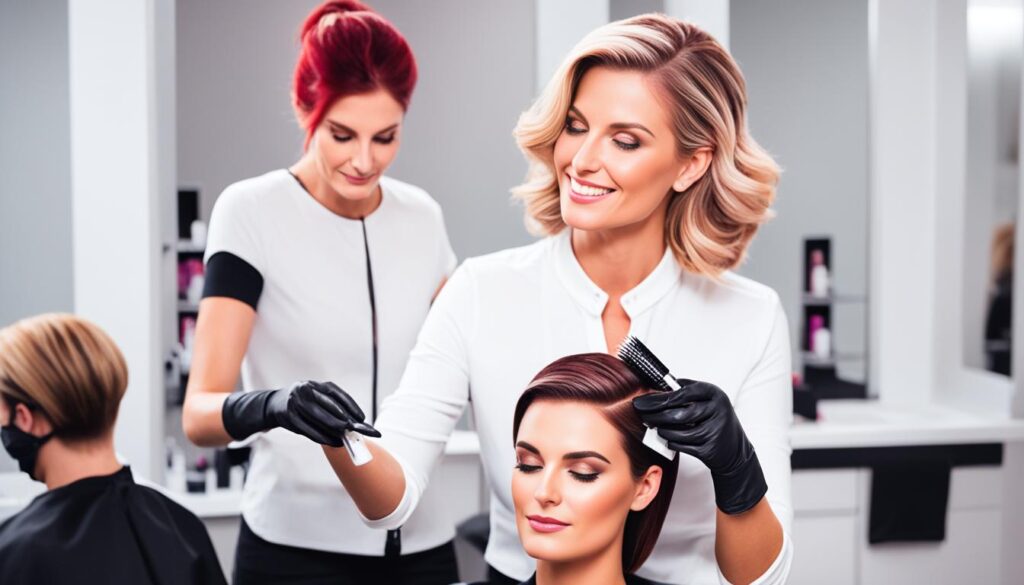
Have you ever wondered about the darkest brown shade on the hair color chart? It’s time to unravel the mystery behind the number 2 hair color. Is it really just a dark brown or does it hide some surprising secrets? Prepare to explore the depths of this rich hue and discover why it’s a favorite among those seeking a natural yet captivating look.
Key Takeaways:
- The number 2 hair color is the darkest brown shade on the hair color chart.
- It appears almost black from a distance but has a subtle brown hue up close.
- Number 2 hair color is warmer and has a more natural look compared to jet black and off black shades.
- Choosing the right hair color involves considering factors such as skin tone, eye color, and desired style.
- Maintaining number 2 hair color requires using color-safe hair care products and regular touch-ups.
Understanding Hair Color Charts
Hair color charts are an essential tool for both professionals and clients in the world of hair coloring. These charts utilize a numbering system that represents various shades and tones of hair colors. By understanding the hair color chart, individuals can make informed decisions about their hair color choices and achieve their desired look.
The hair color numbering system is designed to provide a comprehensive understanding of the different elements that make up a specific hair color. The first number in the chart indicates the base color or the depth level of the hair color. For instance, the number 1 represents black hair, while the number 5 signifies light brown, and the number 10 represents the lightest shade of blonde.
However, the numbering system doesn’t stop at the base color. The second and third numbers after the decimal point in the chart indicate the primary and secondary reflects or tones present in the hair color. These reflects can include ash, iridescent, golden, or copper tones, among others. The combination of these tones adds dimension and character to the hair color, allowing for endless possibilities and customization.
Understanding the hair color chart also involves recognizing the concept of a natural base color. Every individual has a natural base color to their hair, which is determined by their genetics. This base color serves as the foundation upon which hair color transformations are built. By considering the natural base color and the desired end result, hair colorists can create beautiful and harmonious color transformations.
The tone or reflect of a hair color is another crucial aspect to understand. The tone refers to the overall shade of the hair color, whether it is warm, cool, or neutral. Warm tones have a reddish or orange undertone, cool tones have a blue or violet undertone, and neutral tones have a balance between warm and cool. The choice of tone can significantly impact the final look and how it complements an individual’s skin tone and features.
By familiarizing oneself with the hair color chart, individuals can have informed conversations with their hair colorist and make decisions that align with their desired aesthetic. Whether it’s choosing a natural-looking shade that enhances their features or opting for a bold and vibrant color, the hair color chart provides the necessary guidance and understanding to achieve the perfect hair color.
We believe that a thorough understanding of the hair color chart is the cornerstone of successful hair color transformations. It allows individuals to communicate their desires effectively and enables professionals to bring those desires to life.
Examples of Hair Color Numbering System
| Base Color | Tone or Reflect | Hair Color |
|---|---|---|
| 1 | Ash | Black |
| 5 | Iridescent | Light Brown |
| 6 | Golden | Dark Blonde |
| 7 | Copper | Blonde |
| 10 | Ash | Lightest Blonde |
The Difference Between Number 2 and Other Hair Colors
The number 2 hair color differs from other shades such as jet black (1) and off black (1B). While all three shades are dark, there are noticeable distinctions. Jet black has cool, blue undertones, while number 2 has a warmer, brown undertone. 1B is closer to black but is a softer shade with warm undertones. In terms of darkness, jet black is the darkest, followed by 1B, and then number 2. Number 2 hair color is a shade of dark brown, giving it a more natural look than jet black or off black.

Jet black (1) and number 2 hair colors have distinct undertones and darkness levels.
“I love how the number 2 hair color gives me a natural, dark brown look without being too intense like jet black. It’s the perfect balance for my complexion.” – Lisa, satisfied customer.
Customer testimonial highlighting the preference for number 2 hair color.
The Comparison of Number 2 Hair Color with 1B:
While number 2 and 1B hair colors may seem similar, there are notable differences between them. Number 2 is a shade of dark brown, while 1B is closer to black. Number 2 hair color is processed to achieve a uniform hue, while 1B is typically unprocessed and may showcase slight variations, including grays or lighter browns. These disparities should be considered when choosing between the two shades, as they can impact the final look and how well it complements your natural hair.
“I opted for 1B initially, but the slight warmth and natural look of number 2 was a game-changer for me. It matches my skin tone perfectly and gives me the confidence I always desired.” – Sarah, hair color enthusiast.
Customer testimonial highlighting the preference for number 2 hair color over 1B.
Choosing Between Number 2, Jet Black, and 1B Hair Color
When it comes to selecting the perfect hair color, it’s important to consider various factors such as skin tone, eye color, natural hair color, style preferences, and desired look. This section will guide you through the process of choosing between number 2, jet black, and 1B hair color, helping you find the shade that best complements your features and achieves your desired aesthetic.
Matching Hair Color to Skin Tone and Eye Color
An essential consideration when choosing a hair color is the harmony between your hair color, skin tone, and eye color. Each combination produces a unique visual impact and enhances your natural features.
- For individuals with a warm skin tone and warm eye colors such as hazel or brown, number 2 hair color is an excellent choice. Its warm, brown undertones complement the natural warmth of your complexion, creating a harmonious and balanced look.
- If you have a cool skin tone and cool eye colors like blue or green, jet black hair offers a striking contrast that can make your eyes pop and enhance your overall appearance.
- 1B hair color, with its softer warm undertones, works well for those with naturally black hair, providing a subtle and natural-looking shade without too much contrast.
Determining Hair Color Based on Style and Desired Look
Your preferred style and desired look are also essential factors to consider when deciding between number 2, jet black, and 1B hair color. Each shade creates a different effect and aesthetic.
“Number 2 hair color is ideal for those who want to achieve a natural and subtle look. It mimics the shade of natural hair and provides a rich, dark brown color that brings out the depth and dimension of your locks.”
On the other hand, jet black hair color creates a more dramatic effect, adding intensity and sophistication to your overall appearance. This shade is perfect for individuals who want to make a bold statement with their hair.
For those with naturally black hair who desire a more understated look, 1B hair color offers a soft and gentle shade that enhances your existing hair color, providing a touch of depth without overpowering your locks.
Matching Hair Extensions with Leave-Out Style
If you plan to incorporate hair extensions into your hairstyle and opt for a leave-out style, it is vital to ensure that the color of the extensions matches your natural hair.
Tip: To achieve a seamless and cohesive look, consider purchasing hair extensions that are the same shade as your natural hair color or the color you choose for your hair dye.
By selecting the right hair color based on your skin tone, eye color, style preferences, and desired look, you can create a stunning and personalized appearance that enhances your natural beauty. Remember to take your time when deciding, consult with a professional if needed, and most importantly, choose a shade that makes you feel confident and empowered.
| Hair Color | Best Match for Skin Tone | Best Match for Eye Color | Style and Look |
|---|---|---|---|
| Number 2 | Warm skin tones | Hazel or brown eyes | Natural and subtle look |
| Jet Black | Cool skin tones | Blue or green eyes | Dramatic and intense effect |
| 1B | Warm skin tones | Various eye colors | Subtle and gentle look |
Comparing Number 2 and Other Hair Colors
When it comes to hair colors, there are certain shades that may seem similar but have distinct differences. This is the case with number 2 and 1B hair colors. While both shades appear dark, they have unique characteristics that set them apart.
Number 2 hair color is a rich, dark brown shade that provides depth and warmth to your hair. On the other hand, 1B is a shade that is closer to black, with a slightly softer and more subtle appearance. The primary difference lies in the undertones of each color.
“Number 2 hair color is a rich, dark brown shade that provides depth and warmth to your hair.”
Number 2 hair color is usually processed to achieve a uniform shade throughout. This means that each strand is carefully treated to ensure consistent color. Conversely, 1B hair color is usually unprocessed, which allows for slight variations in the color. These variations can include grays or lighter browns mixed in with the overall shade.
Understanding the differences between number 2 and 1B hair colors is crucial when deciding which shade is best for you. It ultimately depends on your personal preference, as well as how well the color matches your natural hair.
Remember to consider factors such as your skin tone and eye color when choosing a hair color. You want to select a shade that complements your features and enhances your overall look. Consulting with a professional hair colorist can provide valuable insights and recommendations tailored to your individual characteristics.
Now that you have a better understanding of the differences between number 2 and 1B hair colors, you can make an informed decision when it comes to coloring your hair. Whether you prefer the richness of number 2 or the subtlety of 1B, both shades can add depth and dimension to your hair, helping you achieve the look you desire.
| Number 2 Hair Color | 1B Hair Color |
|---|---|
| Dark brown shade | Closer to black |
| Warm undertones | Soft and subtle undertones |
| Processed for uniform color | Usually unprocessed with slight variations |
Table: Comparing Number 2 and 1B Hair Colors
Consider these differences and consult with a professional hair colorist to determine which shade will best suit your personal style and enhance your natural beauty.

Factors to Consider When Choosing a Hair Color
When it comes to choosing the perfect hair color, several factors should be taken into consideration to ensure a flattering and balanced look. By considering your skin, hair, and eye color, as well as undertones, you can determine the most suitable shade. Let’s explore these factors in more detail:
Determining Hair Color Based on Skin, Hair, and Eye Color
Your skin, hair, and eye color play a significant role in finding a hair color that enhances your natural features. Cooler complexions, characterized by pink or blue undertones, often suit cooler shades like jet black or ashy browns. On the other hand, warmer skin tones with golden or peach undertones often look great with warmer shades like number 2 or caramel browns. Similarly, eye color can also be a determining factor in choosing a hair color that complements your features.
Considering Undertones
Undertones refer to the underlying pigments in your skin that can influence how specific hair colors look on you. For example, if you have cool undertones, you may find that cooler shades like platinum blonde or ash brown complement your complexion. Warm undertones, on the other hand, can be complemented by warmer shades such as honey blonde or golden brown. Understanding your undertones can help you select a hair color that harmonizes with your natural complexion.
Creating a Balanced Look with Hair Color
Creating a balanced look involves considering various factors, such as your desired style and the natural color of your hair. If you’re looking for a more natural appearance, shades that closely match your natural hair color, like number 2, can provide a seamless blend. Alternatively, if you’re seeking a more dramatic or trendy look, you may opt for bolder colors that contrast with your natural hair color. The key is to find a hair color that not only suits your skin and eye color but also aligns with your personal style and aesthetic.

Hair Color Recommendations by Skin Tone and Undertone
| Skin Tone | Undertone | Recommended Hair Colors |
|---|---|---|
| Cool | Cool | Jet black, ashy brown, platinum blonde |
| Warm | Caramel brown, cool blonde, honey blonde | |
| Warm | Cool | Chestnut brown, ash blonde, cool brunette |
| Warm | Golden brown, copper red, warm brunette |
Remember, choosing the right hair color involves considering multiple factors to achieve a flattering and harmonious look. By taking into account your skin, hair, and eye color, as well as undertones, you can select a hair color that enhances your natural features and reflects your personal style.
Achieving and Maintaining Number 2 Hair Color
Whether you desire a stunning dark brown shade or want to maintain your existing number 2 hair color, there are steps you can take to achieve and preserve this rich hue. From selecting the right hair dye products to implementing effective hair care tips, maintaining your desired shade is within reach.
Achieving Number 2 Hair Color
To achieve number 2 hair color, you have two options: using professional hair dye products or visiting a salon. If you prefer a DIY approach, choose a high-quality hair dye that offers a shade closest to number 2 on the hair color chart. Follow the instructions provided with the product to ensure optimal results. For a more personalized and expert touch, consider consulting with a professional colorist who can help you achieve the exact shade you desire.

Maintaining Dark Brown Hair Color
Once you’ve achieved your desired number 2 hair color, it’s essential to maintain it for long-lasting vibrancy. Here are some tips to help you maintain your dark brown hair:
- Use color-safe shampoos and conditioners specifically designed for dark hair to prevent color fading.
- Avoid excessive exposure to the sun and chlorine, as both can cause color fading and damage.
- Schedule regular touch-ups to prevent the appearance of roots and maintain a consistent color throughout your hair.
- Incorporate regular deep conditioning treatments to keep your hair hydrated and healthy.
- Avoid excessive heat styling, as high temperatures can cause color fading and damage to your hair.
By following these maintenance tips and incorporating them into your hair care routine, you can prolong the life of your captivating dark brown hair color.
Hair Dye Products for Achieving and Maintaining Dark Brown Hair Color
| Product Name | Description |
|---|---|
| L’Oréal Paris Excellence Crème | A permanent hair color that offers long-lasting dark brown results, covering grays and providing intense shine. |
| Garnier Nutrisse Nourishing Color Crème | An nourishing hair color with avocado, olive, and shea oils for vibrant, silky-smooth dark brown hair. |
| Clairol Natural Instincts | A demi-permanent hair color that enhances your natural dark brown shade while leaving hair shiny and conditioned. |
These are just a few examples of popular and effective hair dye products available on the market. Remember to choose a product that best suits your needs and desired results.
With the right tools and hair care practices, achieving and maintaining your gorgeous number 2 hair color is both achievable and rewarding. Embrace your dark brown locks and enjoy the confidence that comes with a hair color that suits your style and personality.
Conclusion
Choosing the right hair color is a personal decision that can greatly enhance your natural features and personalize your look. When selecting a hair color, it is important to consider factors such as your skin tone, eye color, desired style, and natural hair color.
By taking into account these factors, you can find a hair color that complements your complexion, brings out the beauty of your eyes, and aligns with your personal style. Consulting with a professional hair colorist can provide valuable guidance and recommendations based on your individual characteristics.
Ultimately, the goal is to choose a hair color that not only suits your appearance but also makes you feel confident and happy. Whether you opt for the deep richness of a number 2 hair color or the dramatic effect of jet black, the right hair color can enhance your natural beauty and allow you to express your unique style.






